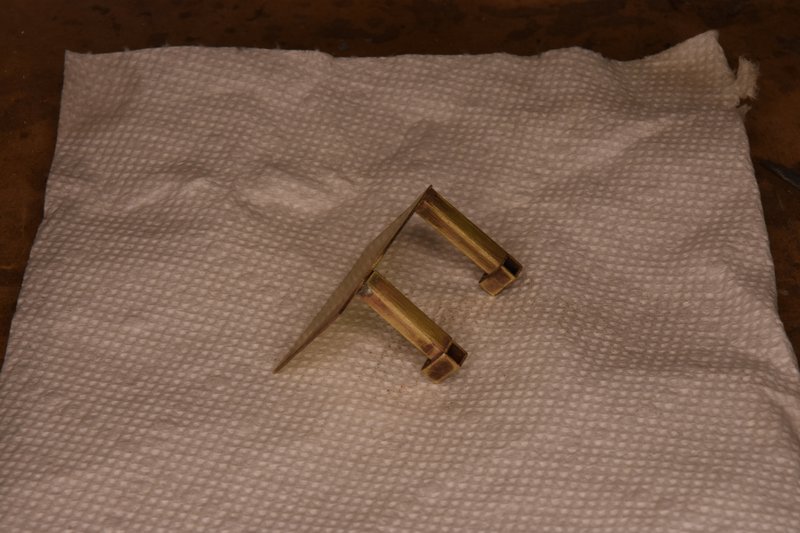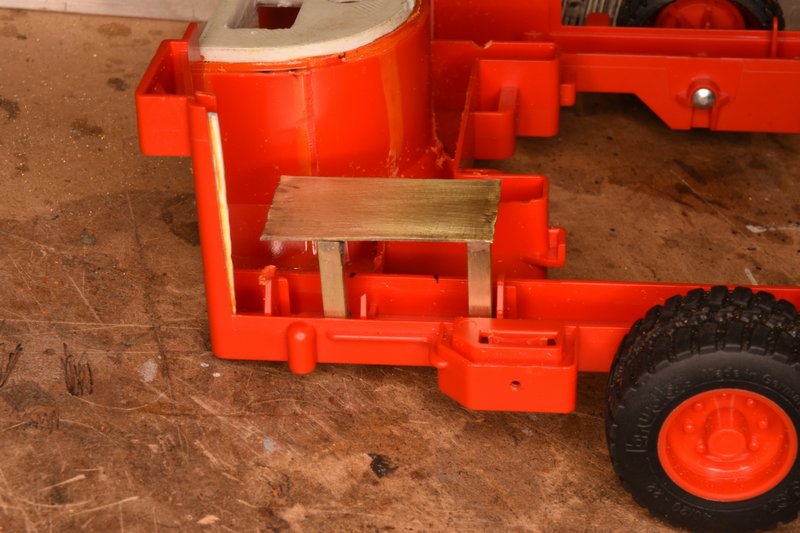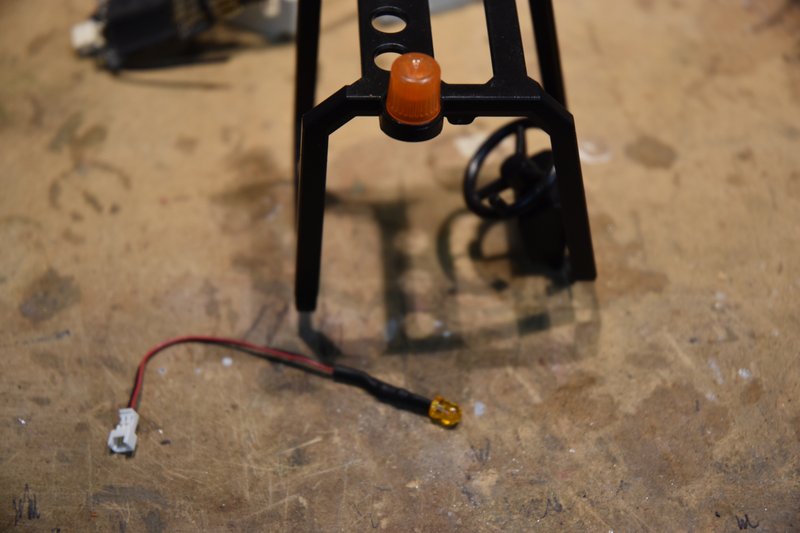Bruder Piggyback Forklift Build part 9
A couple of things to take care of before tackling the electronics. First, if you look back at the last few photos in the last post you see the open area in the body where the battery pack needs to go. You also see that there is the servo and linkage that moves the lift mast assembly in and out. We don't want the battery to hit or obstruct this linkage. So some kind of barrier needs to be made and installed to prevent this. I choose again to use brass but plastic or even wood could be used here as well. I measured the height from the inside bottom of the lower body to the top of the nut holding the ball connector on the servo arm and added 1mm. I just dug out some scrap square tubing and flat plate from my scrap box, cut to size and soldered up the parts as shown below.
[img]

[/img]
The piece fits into the lower body as shown. The 'feet' on the bottom were sized to fit between the outside wall and a rib in the bottom.
[img]

[/img]
Here's another view from a different angle so you can see a little better how the feet fit in. They were drilled for #2 screws and matching holes drilled in the bottom of body.
[img]

[/img]
And here's a view of the bottom showing the mounting screws. Yep, flat head screws now, I finally learned although it doesn't really matter here as there is nothing that needs to move past these screws.
[img]

[/img]
I actually did this part of the build early on which you might be able to tell from the photos. I did this so I could get a better ideal of just how big a battery pack I would be able to fit in. I had originally planned on using a 3S lipo. However the quality of the small ESCs that would work on 3S I discovered are horrible. They either have no real low voltage range to them or they blow out after a few seconds. They all come from China and they must all be made by the same company as it doesn't matter who you get them from they all look alike. I finally decided to try 2S battery and ESCs. This worked much better. I found some ESCs that claimed to be a new design and had a big capacitor hanging off one end. So far they have worked and held up well. The battery I finally settled on is made by a company called SPC Maker. It is 2S and rated 500mAh. It is primarily marketed to the racing drone group. It measures approximately 50x25x13mm and fit in the available space very nicely. And while it looks awfully tiny compared to the size of the batteries we normally use in our trucks and construction equipment I find that I can get a good solid hour of continuous operation out of it, which is plenty for me.
The last thing to be addressed before assembling all the RC electronics is the warning light on top of the ROPs. I didn't put any other working lights on my model but I did want that light to flash. This is a real simple conversion. I used a LED that had it's flashing circuit already built it. These are available from a number of sources, mine came from Eflite. It also included the necessary over-current protection resistor already installed. Photo below shows the light fixture and the LED.
[img]

[/img]
I cut the socket fitting on the end of the wire off so I could add additional wire to the LED. Also if I had left it on I would have had to cut a much larger hole in the body to pass it through to the inside.
To remove the lens, just grab it and twist while pulling up. Mine came right off. Drill a 3mm hole right through the middle of the circle as shown.
[img]

[/img]
There is a lug in the center of the lens that needs to be cut back some so it will sit down on top of the LED. Don't remove it completely as it will act as a light pipe make the lens appear brighter when the LED is lit.
[img]

[/img]
I glued the LED into it's mounting hole from the bottom using CA. After it cured I then bent the wire to follow the inside of the ROPs cage and CAd it in place.
[img]

[/img]
Then the lens was glued back in place over the LED. To prevent possible fogging of the lens from CA I used a watch crystal cement.
The last step was to hold the ROPs in postion on the upper body and mark the location of the notch for the wires from the LED to enter the body.
[img]

[/img]
I crimped a couple of female connector pins to the ends of the LED wires. When installed these will just plug onto the positive and negative pins of the battery port on the receiver. When the receiver is powered up from the BEC of one of the ESCs it will also turn on the flashing LED.
At this time all the modifications are pretty much complete. I had tested each individual servo and motor system as it was installed. Now everything was hooked up and run though it's paces. I was very relieved to find that everything worked as it should. The model was stripped back down and sent to paint. I won't bother with showing any of that, painting is painting. Next post I'll start in on the 3d version of Tetris and figure out how to cram everything into the available space.